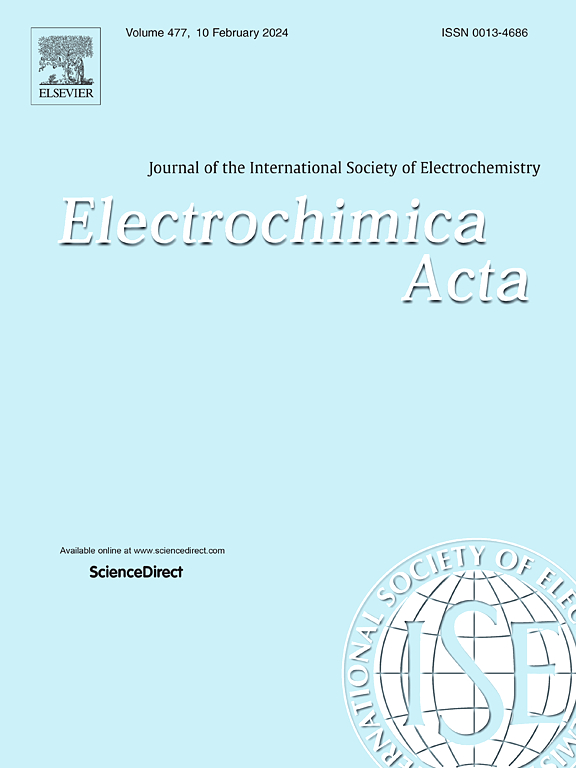用双掺杂CuO催化剂解锁高性能CO2电还原成CO: Sn和Ga对提高选择性和活性的协同效应
IF 5.6
3区 材料科学
Q1 ELECTROCHEMISTRY
引用次数: 0
摘要
多金属电催化剂是指导二氧化碳电催化还原反应(eCO2RR)向有价值产物方向发展的一种有前途的策略。然而,同时实现高选择性和高活性仍然具有挑战性。在这里,我们报道了一种双掺杂的CuO催化剂(CuO- sn0.02 - ga0.005),它协同结合了Sn和Ga,以实现卓越的co2到co转化性能。电化学评价表明,优化后的催化剂在-0.7 VRHE和-132.8 mA cm-2电流密度下对CO的法拉第效率(FE)为99.37%,显著优于原始CuO (54.21%, -47.6 mA cm-2)和单掺杂CuO- sn0.02 (93.50%, -55.3 mA cm-2)和CuO- ga0.02 (46.76%, -94.2 mA cm-2)。Sn掺杂抑制析氢,提高CO选择性,Ga掺杂提高催化活性。原位拉曼光谱显示,Sn的掺入促进了关键中间体(如*COOH)的稳定,而Ga引入了晶格应变和缺陷,扩大了电化学活性表面积。该催化剂还表现出显著的稳定性,在75小时内对CO保持95%的FE。本研究通过双元素掺杂为非贵金属催化剂提供了合理的设计策略,突出了电子和结构调制在eCO2RR中的关键作用。本文章由计算机程序翻译,如有差异,请以英文原文为准。


Unlocking high-performance CO2 electroreduction to CO with dual-doped CuO catalysts: Synergistic effects of Sn and Ga for enhanced selectivity and activity
Polymetallic electrocatalysts represent as a promising strategy for steering the electrocatalytic CO2 reduction reactions (eCO2RR) toward valuable products. However, achieving simultaneous high selectivity and activity remains challenging. Here, we report a dual-doped CuO catalyst (CuO-Sn0.02-Ga0.005) that synergistically combines Sn and Ga to achieve exceptional performance for CO2-to-CO conversion. Electrochemical evaluations demonstrate that the optimized catalyst exhibits a Faradaic efficiency (FE) of 99.37 % for CO at -0.7 VRHE with a current density of -132.8 mA cm-2, significantly outperforming pristine CuO (54.21 %, -47.6 mA cm-2 and single-doped counterparts (93.50 %, -55.3 mA cm-2 for CuO-Sn0.02 and 46.76 %, -94.2 mA cm-2 for CuO-Ga0.02, respectively). Sn doping suppresses hydrogen evolution and enhances CO selectivity, while Ga doping boosts catalytic activity. In situ Raman spectroscopy reveals that Sn incorporation facilitates the stabilization of key intermediates (e.g., *COOH), whereas Ga introduces lattice strain and defects, enlarging the electrochemically active surface area. The catalyst also demonstrates remarkable stability, maintaining >95 % FE for CO over 75 h. This work provides a rational design strategy for non-precious metal catalysts through dual-element doping, highlighting the critical role of electronic and structural modulation in eCO2RR.
求助全文
通过发布文献求助,成功后即可免费获取论文全文。
去求助
来源期刊

Electrochimica Acta
工程技术-电化学
CiteScore
11.30
自引率
6.10%
发文量
1634
审稿时长
41 days
期刊介绍:
Electrochimica Acta is an international journal. It is intended for the publication of both original work and reviews in the field of electrochemistry. Electrochemistry should be interpreted to mean any of the research fields covered by the Divisions of the International Society of Electrochemistry listed below, as well as emerging scientific domains covered by ISE New Topics Committee.
 求助内容:
求助内容: 应助结果提醒方式:
应助结果提醒方式:


